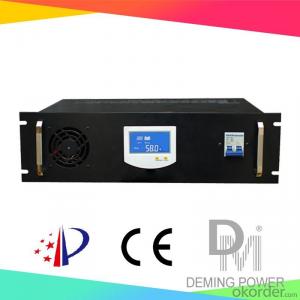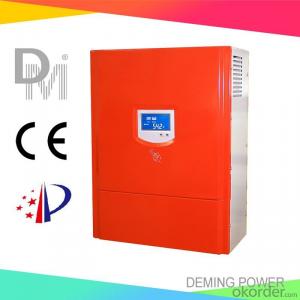MPPT Solar Charge Controller 192V 30A for off grid solar power system and RS485 available
- Loading Port:
- Qingdao
- Payment Terms:
- TT OR LC
- Min Order Qty:
- 1 PCS
- Supply Capability:
- 1000 PCS/month
OKorder Service Pledge
OKorder Financial Service
You Might Also Like
Properties of the solar charge controller
1. Design for off-grid solar power system.
2. Applicable to different kinds of batteries.
3. Adopts MPPT technology (Maximum Power Point Tracking). The advanced tracking algorithm make the solar module operate at ideal voltage which the solar modules can produce the maximum available power.
4. Modular design with simple structure and easy maintenance.
5. Automatic power control function.
6. LCD display: Solar panel current, solar panel voltage, solar panel power, battery group voltage, charge current.
7. Perfect protection function: Solar reverse charge protection, Solar reverse connection protection, Battery reverse connection protection, Battery overcharge protection, Battery over current protection etc ,thus the system has higher reliability.
Technical parameters of the solar charge controller
Model | 192V30A | ||
Battery group rated voltage | 192Vdc | ||
PV Rated current | 30A | ||
PV open circuit voltage | 500V | ||
PV Max. power | 5760Wp | ||
MPPT input DC voltage range | 150-240Vdc | ||
Input PV module road number | 1 | ||
Function | MPPT charge mode, auto stop charge, auto recharge voltage; Protection: connecting contrary, over current, short circuit, over heat etc. | ||
Display mode | LCD | ||
Display content | solar panel voltage, solar panel current, solar panel power, battery voltage, charge current | ||
Floating Charge Voltage (adjustable) | 110Vdc | ||
Stop charge voltage | 116Vdc±1% | ||
Recharge voltage | 108V±1% | ||
Voltage drop between PV and battery | 1.5V | ||
Max itself power consumption | 100mA-150mA | ||
Work environment temperature | -30-60°C | ||
Relative humidity | 90% No condensation | ||
Applicable altitude | 3000m The rated power should be reduced when it is higher than 2000m | ||
Noise (1m) | 40dB | ||
Degree of protection | IP20(Indoor) | ||
Cooling method | Forced air cooling | ||
*Communication interface (optional) | RS485/USB | ||
*Temperature compensation(optional) | -4mv/°C/2V,-35°C~+80°C,Accuracy:±1°C | ||
Product size (mm) | 520*430*200mm, (Black one) 480*360*150mm, (Red one) | ||
Weight(kg) | 12Kg(Black one) 14kg(Red one0 | ||
*Above parameter only for reference. Could be custom made to user specifications.
- Q:What is the maximum discharge power of a solar controller?
- The maximum discharge power of a solar controller depends on its specifications and capacity. It can vary widely, ranging from a few watts for small portable controllers to several kilowatts for larger installations.
- Q:Does a solar controller have a built-in timer function?
- Yes, a solar controller typically has a built-in timer function. This feature allows users to set specific time intervals or schedules for when the solar system should be activated or deactivated. The timer function is especially useful in applications where energy consumption needs to be regulated or when the solar system needs to operate during specific hours of the day. By utilizing the built-in timer function, users can maximize the efficiency and effectiveness of their solar power system.
- Q:Can a solar controller be used with solar-powered marine systems?
- Yes, a solar controller can be used with solar-powered marine systems. A solar controller helps regulate and optimize the charging process of batteries connected to solar panels. This is essential in marine systems as it helps protect the batteries from overcharging and provides efficient power management.
- Q:What is the role of a solar controller in preventing battery over-discharge?
- The role of a solar controller in preventing battery over-discharge is to monitor the energy levels of the battery and regulate the charging and discharging process. It ensures that the battery is not drained beyond a certain threshold, which helps to prolong its lifespan and prevent irreversible damage. The solar controller acts as a safeguard by disconnecting the load from the battery when it reaches a low voltage, preventing over-discharge and maintaining the battery's overall health.
- Q:Can a solar controller be used with a solar-powered wireless network?
- Yes, a solar controller can be used with a solar-powered wireless network. The solar controller is responsible for regulating and optimizing the power generated by the solar panels, ensuring that the wireless network has a constant and reliable power source. By effectively managing the solar energy, the controller helps maintain the functionality of the wireless network even in low light or adverse weather conditions.
- Q:How do I protect a solar controller from overheating?
- To protect a solar controller from overheating, there are several steps you can take: 1. Proper installation: Ensure that the solar controller is mounted in a well-ventilated area, away from direct sunlight and other sources of heat. This will help to prevent excessive heat buildup. 2. Adequate sizing: Make sure the solar controller is properly sized for your solar panel system. Undersized controllers may struggle to handle the load, leading to overheating. Consult the manufacturer's specifications or seek professional advice to ensure the controller is suitable for your system. 3. Check ambient temperature: Monitor the ambient temperature around the solar controller regularly. If the temperature rises above the recommended operating range, consider relocating the controller to a cooler area or installing additional ventilation. 4. Use heat sinks: Consider using heat sinks or heat dissipation devices, especially if the solar controller is located in a confined or enclosed space. Heat sinks help to absorb and dissipate excess heat, preventing it from building up and damaging the controller. 5. Install thermal sensors: Many advanced solar controllers come equipped with built-in thermal sensors that can detect excessive heat and automatically shut down or reduce the load on the controller. If your controller does not have this feature, you can consider installing external thermal sensors to monitor and trigger protective measures when necessary. 6. Ensure proper wiring: Faulty or loose wiring can increase resistance and cause the solar controller to overheat. Regularly inspect the wiring connections and ensure they are secure, tight, and properly insulated. If you notice any signs of damage or overheating, address the issue immediately. 7. Regular maintenance: Regularly clean and inspect the solar controller for any debris, dust, or dirt accumulation, as these can impede proper heat dissipation. Use a soft brush or compressed air to clean the controller gently. By following these steps, you can help protect your solar controller from overheating and ensure its optimal performance and longevity.
- Q:How does a solar controller handle the communication with other devices?
- A solar controller typically handles communication with other devices through various protocols such as Modbus, RS485, or CAN bus. These protocols allow the controller to exchange data and instructions with devices like batteries, inverters, or monitoring systems. The solar controller acts as a central hub, collecting information from connected devices, sending commands, and ensuring coordination between them for efficient solar power management.
- Q:How does a solar controller protect batteries from deep discharge?
- A solar controller protects batteries from deep discharge by continuously monitoring the battery voltage and cutting off the charging current when it reaches a certain low level. This prevents the batteries from being over-discharged, which can cause irreversible damage and reduce their lifespan.
- Q:Can a solar controller be used with any type of solar panel?
- No, a solar controller cannot be used with any type of solar panel. The compatibility between the solar controller and the solar panel depends on various factors such as the voltage and current ratings of the panel, as well as the type of technology used in the panel (e.g., monocrystalline, polycrystalline, or thin-film). It is important to ensure that the solar controller is compatible with the specific characteristics of the solar panel to ensure optimal performance and safety.
- Q:What is the maximum communication distance of a solar controller?
- The maximum communication distance of a solar controller typically depends on the specific model and its technology, but it can range from a few meters to several hundred meters, depending on factors such as signal strength, interference, and line of sight.
1. Manufacturer Overview |
|
|---|---|
| Location | |
| Year Established | |
| Annual Output Value | |
| Main Markets | |
| Company Certifications | |
2. Manufacturer Certificates |
|
|---|---|
| a) Certification Name | |
| Range | |
| Reference | |
| Validity Period | |
3. Manufacturer Capability |
|
|---|---|
| a)Trade Capacity | |
| Nearest Port | |
| Export Percentage | |
| No.of Employees in Trade Department | |
| Language Spoken: | |
| b)Factory Information | |
| Factory Size: | |
| No. of Production Lines | |
| Contract Manufacturing | |
| Product Price Range | |
Send your message to us
MPPT Solar Charge Controller 192V 30A for off grid solar power system and RS485 available
- Loading Port:
- Qingdao
- Payment Terms:
- TT OR LC
- Min Order Qty:
- 1 PCS
- Supply Capability:
- 1000 PCS/month
OKorder Service Pledge
OKorder Financial Service
Similar products
New products
Hot products
Hot Searches
Related keywords

































